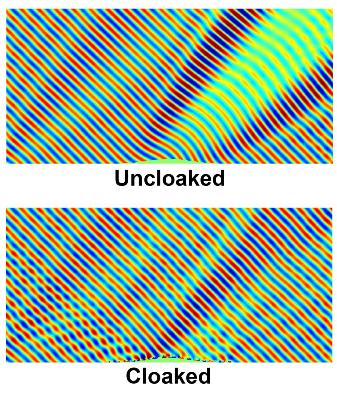Engineers at the University of California, San Diego have designed and developed a thin cloaking device that has seemed to solve some of the shortcomings faced in the development of “invisibility cloaks.”
This new device does not modify the light’s brightness surrounding a hidden object. The technology involved in this invisibility cloak device holds promise in optical communications to boost signal speed, and also for concentrating solar energy applications.
 The reflection pattern from an uncloaked object on a flat surface (top) compared to the reflection pattern of the same object covered with the cloaking device (bottom), which effectively mimics the reflection from a completely flat surface. Image credit: Li-Yi Hsu / UC San Diego.
The reflection pattern from an uncloaked object on a flat surface (top) compared to the reflection pattern of the same object covered with the cloaking device (bottom), which effectively mimics the reflection from a completely flat surface. Image credit: Li-Yi Hsu / UC San Diego.
“Invisibility may seem like magic at first, but its underlying concepts are familiar to everyone. All it requires is a clever manipulation of our perception,” said Boubacar Kanté, a professor in the Department of Electrical and Computer Engineering at the UC San Diego Jacobs School of Engineering and the senior author of the study. “Full invisibility still seems beyond reach today, but it might become a reality in the near future thanks to recent progress in cloaking devices.”
Cloaks are used to cover objects so that they appear to be invisible. Cloaking is aimed at making the object less detectable to light, radar and other such electromagnetic waves. In order for the object to be less detectable, the scattering of electromagnetic waves of the object is changed. However, cloaking devices are generally bulky, which is disadvantageous.
“Previous cloaking studies needed many layers of materials to hide an object, the cloak ended up being much thicker than the size of the object being covered,” said Li-Yi Hsu, electrical engineering Ph.D. student at UC San Diego and the first author of the study. “In this study, we show that we can use a thin single-layer sheet for cloaking.”
Another significant disadvantage in existing cloaking devices is that they are “lossy.” When compared to the light that hits their surface, the light reflected is at a lower intensity.
“Imagine if you saw a sharp drop in brightness around the hidden object, it would be an obvious telltale. This is what happens when you use a lossy cloaking device,” said Kanté. “What we have achieved in this study is a ‘lossless’ cloak. It won’t lose any intensity of the light that it reflects.”
The lossy effect in most cloaks is due to the fact that metal particles are used in these cloaks, and these absorb light. In the new cloak, the researchers used dielectric materials. These materials do not absorb light and are non-conductive.
Teflon and a proprietary ceramic material, both dielectric materials, were utilized in this cloak. These materials were structurally tailored in a specific manner so that the way in which the light waves got reflected off of the cloak were changed.
The research team designed a “carpet” cloak that was designed to cloak an object that was placed or seated upon a flat surface. The complete system comprising the surface and the object is made to appear flat.
The light’s reflection of the flat surface is mimicked to achieve this effect. Light from flat surfaces is reflected in a different manner by objects. However, when the cloak is used to cover the object, the light from various points is reflected in an out of synchronisation manner. This leads to effective cancellation of the light distortion that occurs due to the shape of the object. “This cloaking device basically fools the observer into thinking that there’s a flat surface,” said Kanté.
The cloak was designed and made effective using CAD software along with electromagnetic simulation. The team modeled the cloak as a thin Teflon matrix that had small embedded cylindrical ceramic particles. Each of these particles was provided a different height, based on their location on the cloak.
“By changing the height of each dielectric particle, we were able to control the reflection of light at each point on the cloak,” explained Hsu. “Our computer simulations show how our cloaking device would behave in reality. We were able to demonstrate that a thin cloak designed with cylinder-shaped dielectric particles can help us significantly reduce the object’s shadow.”
“Doing whatever we want with light waves is really exciting,” said Kanté. “Using this technology, we can do more than make things invisible. We can change the way light waves are being reflected at will and ultimately focus a large area of sunlight onto a solar power tower, like what a solar concentrator does. We also expect this technology to have applications in optics, interior design and art.”
This study entitled “Extremely Thin Dielectric Metasurface for Carpet Cloaking” has been published in the Progress In Electromagnetics Research journal.
The Calit2 Strategic Research Opportunities (CSRO) program at UC San Diego’s Qualcomm Institute has supported this study.